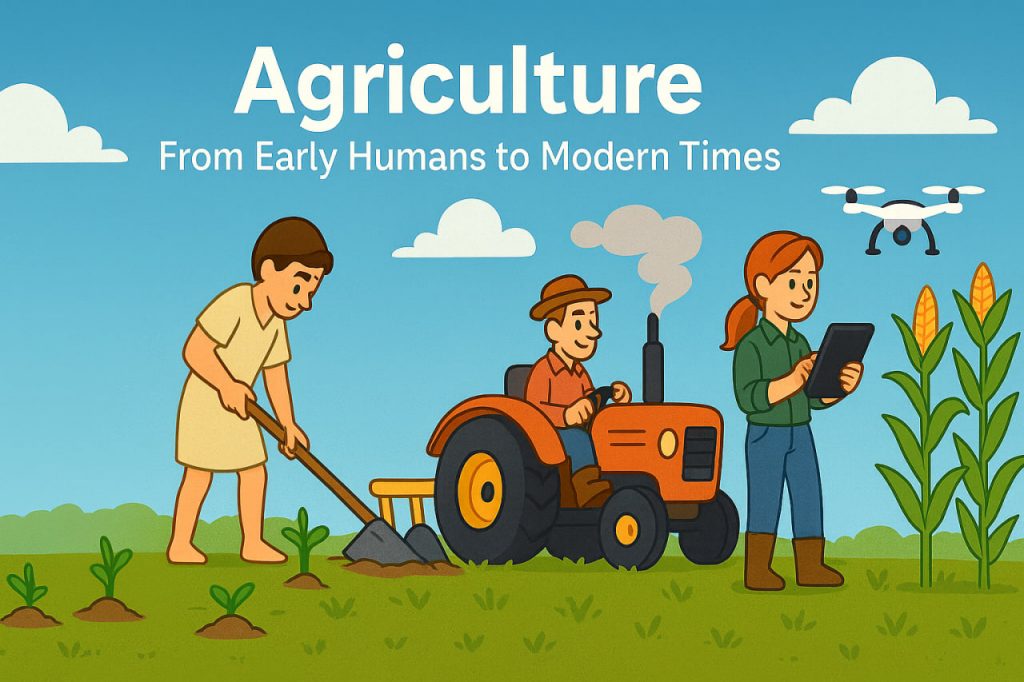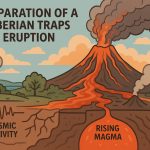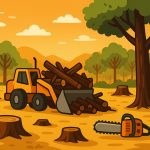As far as we know today аgriculture began around 10,000 years ago during the Neolithic Revolution. Before this, early humans lived as hunter-gatherers, relying on wild plants and animals for food. Gradually, they discovered that seeds could be planted and cultivated, leading to the first farming practices. This shift allowed people to settle in one place instead of moving constantly in search of resources. Early crops included wheat, barley, rice, and maize, depending on the region. Domestication of animals such as sheep, goats, and cattle soon followed, laying the foundation of agricultural societies.
Agriculture in Ancient Civilizations
As societies developed, agriculture became more advanced. In Mesopotamia, farmers used irrigation systems to control water from the Tigris and Euphrates rivers. Ancient Egypt relied on the annual flooding of the Nile to enrich soil for farming. In Asia, rice cultivation spread across river valleys, while the Americas developed maize-based agriculture. These practices supported the growth of cities, trade, and cultural achievements. Agriculture was no longer only about survival—it became the basis of economic and political power.
Medieval and Early Modern Agriculture
During the Middle Ages, innovations such as the three-field system, crop rotation, and heavy plows improved productivity in Europe. In other parts of the world, advanced terracing systems and irrigation supported farming in mountainous or dry regions. By the early modern period, global exploration led to the Columbian Exchange, which introduced crops like potatoes, tomatoes, and corn to new continents. This global exchange reshaped diets and economies, creating a more interconnected agricultural world.
The Agricultural Revolution
The Agricultural Revolution of the 18th and 19th centuries transformed farming once again. The introduction of machinery, such as seed drills and threshers, reduced labor and increased yields. Selective breeding improved livestock quality, while better farming techniques enhanced efficiency. These changes supported rapid population growth during the Industrial Revolution. Farming became more commercial, producing not only food but also raw materials for industries. This marked the beginning of agriculture as a central part of global economies.
Modern Agriculture
Today, agriculture is a highly technological and globalized system. Farmers use tractors, harvesters, and irrigation systems powered by modern engineering. Fertilizers, pesticides, and genetically modified organisms (GMOs) increase productivity but raise environmental and ethical debates. Precision agriculture, using satellites and drones, allows farmers to monitor soil, crops, and water more effectively. Global supply chains make it possible for food to travel thousands of kilometers, feeding billions of people. At the same time, agriculture contributes to climate change, deforestation, and biodiversity loss, creating new challenges for humanity.
The Future of Agriculture
The future of farming lies in balancing productivity with sustainability. Organic farming, vertical farming, and hydroponics offer alternatives that reduce environmental impact. Advances in biotechnology may create crops resistant to disease and climate stress. Smart farming powered by artificial intelligence and robotics promises to revolutionize efficiency. However, solving global hunger and protecting ecosystems will require international cooperation. Agriculture remains one of humanity’s most important tools for survival and progress, just as it was for early humans.
Conclusion
From the first planted seeds to the age of AI-powered farming, agriculture has shaped human history. It allowed people to settle, form civilizations, and build global societies. Modern agriculture provides food for billions but also brings environmental challenges that must be addressed. By learning from the past and applying innovation responsibly, humanity can ensure agriculture continues to sustain life while protecting the planet.
Please remember that everything you see here is based on assumptions and archaeological findings, and we don’t really know how it happened.
Glossary
- Agriculture – the practice of cultivating plants and domesticating animals for food and resources.
- Neolithic Revolution – the period when humans shifted from hunting and gathering to farming.
- Hunter-gatherers – early humans who relied on wild plants and animals for survival.
- Irrigation – supplying water to land or crops artificially.
- Columbian Exchange – global transfer of crops, animals, and culture between the Old and New Worlds.
- Agricultural Revolution – period of major agricultural advancements in the 18th–19th centuries.
- Precision agriculture – modern farming techniques using technology to optimize productivity.


